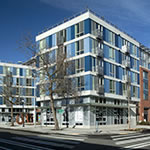For Palo Alto, California-based Essex Property Trust, there’s no place like home—especially if that home is in an apartment building. The publicly traded S&P 400 real estate investment trust, or REIT, acquires, develops, and manages large, multiunit communities and specializes in supply-constrained markets.
The company has more than 30,000 apartment units in approximately 163 multifamily properties strictly along on the West Coast, from San Diego to Seattle. “Other people try to take on too much and move to other areas, and expand constantly,” says Jeff Lambert, the company’s senior vice president charged with running all new construction projects and acting as development manager. “But the stock market is continually rewarding us for not trying to oversize or overgrow and just stay in these markets.”
Although sustainability has been a concern for Essex since its inception, the company’s fiduciary responsibility to its stockholders means that it has to do the best it can within constrained budgets; without enough long-term, return-on-investment data, it has been difficult to justify additional costs. Fortunately for Essex, the two states in which it primarily works, California and Washington, have placed sustainable construction in the limelight, making it mandatory through tighter energy codes. The increased scrutiny has made achieving LEED certification far easier to reach.
Essex previously has employed the GreenPoint Rated system for projects in California and Built Smart for projects in Seattle because those certifications are more friendly to wood-frame construction, Essex’s preferred way to build. But with recent changes to LEED for Homes for mid-rise buildings, Essex is fully embracing the rating system.

Comprising two buildings called Mosso One and Mosso Two for a total of 463 units, Mosso Apartments is hoping to achieve LEED Gold certification. Both buildings are nine stories tall, with matching glass and aluminum curtainwalls and interiors that employ recycled and local materials. This is Essex’s first project in San Francisco, and, when it broke ground in June 2012, was also the company’s first LEED project for Type 1 construction. Not just meeting, but surpassing California’s Title 24 required the help of general contractor Webcor, who also served as the project’s LEED consultant.
“We do projects from the 150-unit range,” Lambert says, “but it’s usually closer to the 200 mark, and at that quantity, every little thing you do becomes a multiplier.” Concentrating on such large projects means every aspect must be closely dissected. It’s not installing a system—it’s installing a system 200 times. As both developer and manager, Essex analyzes both up-front and operational costs, weighing them against what tenants expect from their properties. Sustainability, however, is attractive to Essex, which will own the building over the long term. Particularly big items like HVAC systems become major challenges because such decisions are nearly impossible to take back. Lambert says that to reach Essex’s desired SEER levels, he mostly employs high-efficiency, ductless systems, saving both energy and space.
The firm has learned a lot through trial and error, including how to balance sustainable additions with a positive impact on the bottom line. “Getting through the energy model is the most difficult aspect,” Lambert says. But with the introductions of so many green products in the recent past, Lambert and his firm have seen their building processes become increasingly smoother as they become more accustomed to them.
Essex begins by going through a checklist in the design phase of what materials are going to be used and what elements are needed to make an appealing apartment. The design-development phase determines which building rating system will be used so that all consultants know whether to approach the building through the LEED lens or something like GreenPoint.
The company’s ultimate goal is to create a product that appeals to its tenant base. In its high-demand areas, such as Seattle, Lambert finds that the clientele is more well-versed in environmental subject matter than ever before. Creating apartments that appeal to that demographic is a top concern and, therefore, aligns with sustainability; LEED not only helps Essex as a building manager, but also is a major selling point for future tenants. By building more responsibly, with responsible products, the company hopes to create a healthy lifestyle that appeals to both the sustainability specialist and the neophyte.

